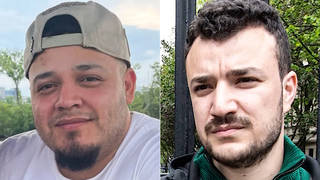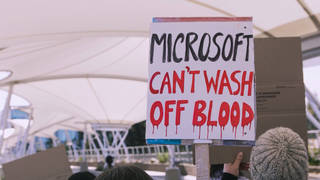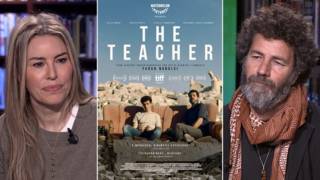
Guests
- Sherif MansourMiddle East and North Africa program coordinator for the Committee to Protect Journalists.
Gaza is now the deadliest place on Earth for media workers. By some estimates, over 110 journalists have been killed there since Israel began its assault on the territory following the October 7 Hamas attack, and the Committee to Protect Journalists says more journalists were killed in the first 10 weeks of the war than have ever been killed in a single country over an entire year. We speak with CPJ’s Middle East and North Africa coordinator Sherif Mansour, who says journalists in Gaza are showing great courage amid horrific working conditions. “They really are rewriting what it means to be a journalist today with immense, brave and never-seen-before sacrifices,” Mansour says.
Transcript
AMY GOODMAN: Israel’s bombardment of Gaza from the land, air and sea continued today, much of it in the southern part of the territory in the cities of Khan Younis and Rafah. At least 163 Palestinians have been killed in Gaza in the last 24 hours, according to the Gaza Health Ministry. Some of the worst shelling hit the western side of Khan Younis, which was designated in the early stages of Israel’s assault on Gaza as a so-called safe zone by Israel. There’s also been intense Israeli bombardment in the vicinity of Nasser Hospital, the main hospital in the city, and tanks and armored vehicles are on the main road leading to the area. Among the places hit in Khan Younis was a school sheltering displaced Palestinians. An eyewitness described the attack.
EYEWITNESS: We saw death with all colors. The tanks entered. We saw everything vividly. It was horrible — random shelling, random fire, random killing. They are coming just to kill and go back home. This is a Nakba. They are just coming to kill children, women, elderly, in the bathroom, in the school, in the hospital, in the street, anywhere. They killed us. They are just coming to kill only. Just that. Just killing.
AMY GOODMAN: The interruption of communications and internet services in Gaza, for days, has continued for the fifth consecutive day, the longest telecommunications blackout of the war so far. This has caused delays for emergency workers to respond to airstrikes and has hampered media coverage from Palestinian journalists in Gaza.
Meanwhile, Al Jazeera’s bureau chief Wael al-Dahdouh left Gaza on Tuesday, crossing into Egypt, then flying to Qatar to receive medical treatment. Dahdouh has come to symbolize both the suffering and resilience of Palestinian journalists in Gaza. In October, four members of his family were killed, including his wife, his 15-year-old son, his 7-year-old daughter and his grandson, in an Israeli strike on a refugee camp where they were seeking shelter after their home was bombed. Last week, his eldest son, 27-year-old-Hamza, also a journalist, was killed along with another journalist in an Israeli airstrike on their car in Khan Younis. Dahdouh will receive medical treatment in Doha for a wound he received when Israel bombed the area he was in that ended up killing his cameraperson Samer Abudaqa.
By some counts, over 110 journalists have been killed in Gaza since October 7th. The Committee to Protect Journalists has found more journalists have been killed in the first 10 weeks of Israel’s war on Gaza than have ever been killed in a single country over an entire year.
For more, we’re joined by two guests. Sharif Abdel Kouddous is an independent journalist and a Democracy Now! correspondent. His latest piece for The Intercept investigates the killing of Abudaqa. It’s headlined “Israel Bombed an Al Jazeera Cameraman — and Blocked Evacuation Efforts as He Bled to Death.” He’s joining us from here in New York. In Washington, D.C., we’re joined by Sherif Mansour, the Middle East and North Africa program coordinator for the Committee to Protect Journalists.
We welcome you both to Democracy Now! Before we talk to Sharif about the cameraman, the Al Jazeera cameraman who bled to death over five hours, can we put this in a broader context, Sherif Mansour? Talk about the astounding number, the horrific number, of journalists who have died in Gaza.
SHERIF MANSOUR: Well, thank you for having me again, Amy. I’ve already talked to you about this at least twice, and the number only goes higher. The deadly pattern we discussed become more deadly. And we have since talked, talked about the apparent pattern of targeting against journalists, their families. And specifically when we discuss Al Jazeera and al-Dahdouh’s family, they really are rewriting what it means to be a journalist today, with immense, brave and never-seen-before sacrifices. The Palestinian journalists, local journalists — so far, 76 out of 83 we’ve counted since the start of the war are Palestinians. The overwhelming majority are killed by the Israeli army. The Israeli army has killed more journalists in the span of those three months than any other entity or army have done over a course of one year since 1992. This is the most dangerous and the most — we’ve never seen any assignment like this before.
Of course, what we called on is independent and transparent and thorough investigation. We want to see the case of al-Dahdouh, his son, Al Jazeera and others that show a culpability of the Israeli army to be put to public scrutiny by allowing immediate entry to international media and international investigators into Gaza without censorship by the Israeli army. The killing must stop. And for that to happen, the record must be made public, and U.S., European and other allies of Israel need to call Israel on that record and ensure those investigations are made immediately public.
JUAN GONZÁLEZ: And, Sherif Mansour, what has been the response of the Israeli government and the Israeli Defense Forces, given the enormous number of journalists killed? Have they accepted any culpability at all for any of these killings?
SHERIF MANSOUR: The cases of precise attacks by drones against Al Jazeera, which happened at least twice in the last four weeks, included for the first time the Israeli army taking responsibility of doing those attacks, but also doing as they’ve done in the past, when they are held responsible because the case of a journalist is someone who was behind an international news organization. They said they will investigate, but they also push false narratives, claims that they are terrorists or that they were part of an ongoing crossfire, and, as we’ve seen in past incidents before this war, this time around three narratives pushed by the Israeli army, correcting and changing and providing nothing more than a questionable document, with English for the first time, coming from what they said was a terrorist group, but providing no other evidence that support their claim, and have — so far, the outlets, eyewitnesses, and the families of the journalists have denied the Israeli army narratives and showed to the contrary that, for example, Hamza, an Al Jazeera journalist, was approved to travel — before his father, Wael Dahdouh, did yesterday — after Israel vetted him. And if he was wanted by any chance, he wouldn’t have had this approval before he was killed. And other testimony and accounts that we and others are showing the contradicting nature of these narratives, this is also the same narrative we said happened before this war started, in our “Deadly Pattern” report. And it is a pattern of responses designed to evade responsibilities by throwing the word “terrorists,” by also pushing out those narratives until the world look away.
JUAN GONZÁLEZ: Well, and Human Rights Watch and Amnesty International are both calling for Israel to be officially investigated for war crimes and its targeting of journalists, not only in Gaza, but outside of Gaza, because an internal Reuters investigation found that one of its journalists, Issam Abdallah, was killed by an Israeli tank shell fired on him and a group of six other journalists in southern Lebanon on October 13th. Could you talk about these attacks outside of Gaza?
SHERIF MANSOUR: So, we saw the same pattern of disregard for press insignia that we reported before this war, 13 out of 20 journalists killed by IDF fire over 21 years who wore press signs and press insignia showing that they are media personnel. And like those cases, the case of Issam Abdallah show, with independent investigation, physical proof, forensic proof from the scene, in addition to mapping, audio and visual analysis by international human rights groups and international media organizations, that show that those journalists did not pose any threat to Israeli government positions, that they have been seen by an Israeli drone at least an hour, that they were visibly expressing or showing press signs and only their cameras, and the position that they have taken was a high-vantage hill that did not obscure their location with being close to any camera or house that justified that they would have any threat. And all of this and other evidence have shown that what we show in the past, in the cases of at least three journalists that we categorized as murdered before this course, including Shireen Abu Akleh and Yaser Murtaja and Ahmed Abu Hassin, who were killed in Gaza, that there was no justification for the use of lethal force by the Israeli army. And those and other cases [inaudible] that we call for independent investigation as war crimes, because the Israeli army did not live up to their commitments and obligation under international law.
AMY GOODMAN: And, of course, Shireen Abu Akleh was killed May 11, 2022, outside the Jenin refugee camp. Sharif Abdel Kouddous did a George Polk Award-winning documentary on the killing of Shireen Abu Akleh. He’s joining us, as well.











Media Options